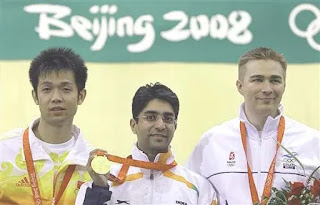Professor Satish Dhawan was an Indian mathematician and aerospace engineer, widely regarded as the father of experimental fluid dynamics research in India. Professor Dhawan was one of the most eminent researchers in the field of turbulence and boundary layers, leading the successful and indigenous development of the Indian space programme.
Aug 8, 2021
Indian Stars 7
Anju Bobby George is India first and only World Champion in the IAAF World Athletics Final. Anju Bobby George made history when she won the bronze medal in long jump at the 2003 World Championships in Athletics in Paris. With this achievement, she became the first Indian athlete ever to win a medal in a World Championships in Athletics.
Aug 4, 2021
Indian Stars 6
Sanjeev Kapoor
Sanjeev Kapoor is a famous Indian celebrity chef, entrepreneur and television personality. Kapoor hosted the popular TV show Khana Khazana, the longest running show of its kind in Asia which was broadcast in 120 countries and in 2010 had more than 500 million viewers. He is also the first chef in the world to own a 24X7 food and lifestyle channel.
"क्या पक रहा हैं?"
Indian Stars 5
Geet Sethi
Geet Siriram Sethi of India is a professional player of English billiards who dominated the sport throughout much of the 1990s. He is a six-time winner of the professional-level and a three-time winner of the amateur World Championships, and holder of two world records, in English billiards. He, along with Prakash Padukone, has co-founded Olympic Gold Quest, a Foundation for the Promotion of Sports in India.
Indian Stars 4
Paresh Rawal
Paresh Rawal (born 30 May 1955) is an Indian actor, comedian and film producer known for his works notably in Hindi films.
Indian Stars 3
Viswanathan Anand is an Indian chess grandmaster and former world chess champion. He became the first grandmaster from India in 1988, and is one of the few players to have surpassed an Elo rating of 2800, a feat he first achieved in 2006. Anand is a five-time world chess champion.
Indian Stars 2
Leander Paes and Mahesh Bhupathi
The first pair to reach the finals of all Grand Slams in a year in the Open era, winning French Open and Wimbledon as top seeds.
Indian Stars 1
In the list of people who made India proud, our first name is Shooter "Abhinav Bindra".
Abhinav Bindra is the lone Olympian who won gold for India in individual event till date.
Jul 27, 2021
Basic Chess Ending 8 - Bishop and Kight
Important principle to keep in mind in this ending are:
- The superior side must use all of his pieces, especially King, to create a "wall" as opposed to a box.
- The weaker King can be mated only in the corner of the same color as the Bishop i.e. the ones that can be attacked by Bishop.
- Try not to focus on checking the King and instead try to focus on surrounding the King, and limiting his moves.
- It is important to note that when playing a waiting move in this ending, you should NEVER use the Knight. Only play waiting moves with the King or Bishop.
- Technique of opposition is used to confine the weaker King.
Jul 26, 2021
Basic Chess Ending 7 - Two Bishops
There is no box strategy for mating with the two bishop. Instead, there are following principles at work:
- Use the Bishops to cut off two "connected" diagonals at the same time. This traps the defending King in one sector of the board.
- The Bishops will be able to take away other important squares while also making whole diagonals impassable.
- The player with the two Bishops must utilize his King more aggressively.
- Chase the defending King to a corner.
1...Ke4 2.Ke2 Kd4 3.Kf3
3...Ke5 4.Be3
3...Kd5 4.Kf4 Kd4 5.Be2 Kd5 6.Be3
Jul 25, 2021
Basic Chess Ending 6 - Two Knights
The odd case of two Knights vs. King is the most frustrating situation. The first thing that must be understood is that White only has a chance to deliver mate in this endgame if black's King willingly steps onto a corner square.
1...Kf8
1...Kh8?? 2.Nf7#
Basic Chess Ending 5 - Lone Queen
White cannot checkmate Black with the White Queen alone. White King must trek across the board and assist in the execution. Checkmate with a King and Queen can be accomplished only at the board edge.
From diagram, White proceed with the endgame as follows:
1.Qb5
With this move, White is trapping the Black King in a "box". The box method of checkmate is easiest, though slightly faster methods are also possible. The strategy here is to make the box smaller and smaller. After White Queen has trapped the Black King on the back rank, White King will march over and assist the Queen.



























































